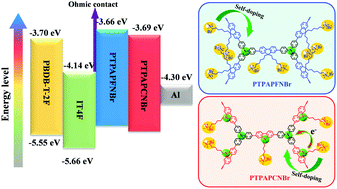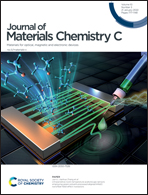Quasi-three-dimensional self-doped conjugated polyelectrolytes based on a triphenylamine skeleton for non-fullerene organic solar cells†
Abstract
The electron transport layers (ETLs) of non-fullerene organic solar cells (NOSCs) are crucial to modulate the work function (WF) of the electrode and restrict the recombination of electron–hole pairs. Herein, two novel quasi-three-dimensional self-doped conjugated polyelectrolytes (CPEs) based on a triphenylamine skeleton, PTPAPFNBr and PTPAPCNBr, are developed and used as ETLs of NOSCs. The quasi-three-dimensional hyperbranched structure enables them to have more polar groups, which is favorable to generate more dipoles and lower the WF, thus realizing a favorable ohmic contact. Simultaneously, the n-type self-doping effect can dramatically increase the electrical conductivity of PTPAPFNBr and PTPAPCNBr. Consequently, compared with the reference device (6.55%), the devices using PTPAPFNBr and PTPAPCNBr as ETLs exhibit prominently enhanced performance with optimal power conversion efficiencies (PCEs) of 10.68% and 11.39%, respectively. The superior PCE of the device with the PTPAPCNBr ETL is principally due to the additional n-type self-doping originating from the lone pair electrons of carbazole. Furthermore, benefitting from the high conductivity of over 4 × 10−4 S cm−1, the devices based on the PTPAPFNBr and PTPAPCNBr ETLs can still function efficiently under thicknesses of approximately 23 nm and 26 nm, respectively. Accordingly, quasi-three-dimensional hyperbranched CPE ETLs with numerous polar groups and self-doping behavior provide a potential pathway to enhance the PCE of NOSCs.



 Please wait while we load your content...
Please wait while we load your content...